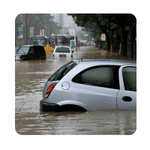Business Recovery: What to Do After a Natural Disaster Strikes?
According to the Federal Emergency Management Agency (FEMA), 40%-60% of businesses do not recover from the aftermath of a natural disaster. This is primarily due to the lack of a business backup and disaster recovery (BDR) plan in the organization.
Disasters happen. Incidents like hurricanes, earthquakes, and flooding can and will destroy your business if you don’t have the right preemptive and corrective plans put in place. This is why every business owner is encouraged to set up a robust business continuity plan to survive or at least lessen the damage brought about by these unforeseen events.
However, 20% of businesses are still not taking precautions despite the risks. If you are in that percentage, and, heaven forbid, your business got affected by a violent storm or blizzard, leaving all your business property and data in shambles, what do you do next?
Whether your building was physically underwater or you’re simply suffering from extended power outages, taking the first steps towards IT disaster recovery is critical. If you don’t take action fast, you just might be part of the 40% that will not survive.
Here at Intelligent Technical Solutions, we’ve been helping hundreds of clients avoid major business disasters by managing their technology. To recall one incident, we’ve had a client who suffered from a massive fire in the past but was able to quickly get back into the business with very minimal damage. That is with an adequate BDR in place.
In this article, we’ll go over the steps you’ll need to take if a natural disaster strikes your business unprepared.
How to Ensure Business Recovery After a Natural Disaster
In the event that you find yourself in the aftermath of a calamity with no contingency plan ready, take note of the important steps you must follow:
 Step 1: Assess the damage
Step 1: Assess the damage
Hopefully, the majority of your data and software were stored offsite, in which case it comes down to ensuring your team can gain access to it.
Focus on getting these critical digital functions online first. Yes, even while floodwaters are high, and winds are still blowing. Once your family and staff are safe, of course.
You may find yourself in a situation where you have remote access to your data. But then you have no idea if your office is still standing, or whether hard-copy records, machinery, and stock were damaged.
Under those circumstances, you will need to assess the damage first by doing an ocular visit to your physical office and proceed from there.
 Step 2: Establish a temporary home and take advantage of loans
Step 2: Establish a temporary home and take advantage of loans
Finding a temporary place where you can declare a home base for your business is a critical first step towards rebuilding.
Any location will do in a pinch if your building is uninhabitable or inaccessible. If you can’t reopen in your current location, plenty of low-interest loans are available to help you get your business back up and running. Here are a few options to explore:
- Apply for Small Business Administration or United States Department of Agriculture (USDA) disaster loans (depending on your type of business).
- Create a GoFundMe or other fundraising account.
- Apply for federal disaster assistance with FEMA.
While you may not want to add debt to your organization during this challenging time, it’s more important to return to something resembling normal operating levels as quickly as possible. This is one of the best ways to ensure the long-term viability of your business.
Even if employees have to work remotely in a fast-food dining room to have power and access to the Internet, they need a way to contact key clients and suppliers. These loans can help you re-establish operations, purchase inventory, start cleanup efforts, rent a temporary space, and get back online quickly.
 Step 3: Accept assistance
Step 3: Accept assistance
The U.S. government provides a variety of assistance options, from crisis counseling services like the Crisis Counseling and Assistance and Training Program (CCP) to tax relief for businesses struggling after a recent natural disaster. Ask to receive expedited refunds or even delay your tax filings—this is especially important if your pertinent physical records were destroyed.
Look into various tax-relief options on www.IRS.gov.
Free legal services are also available from FEMA to assist with landlord agreements, insurance claims, and more. If you want to learn about all of your options in one place, you may check out this free online questionnaire. It provides targeted recommendations for services that will best support your organization.
 Step 4: Consider your options
Step 4: Consider your options
Perhaps there are changes you’ve been planning to implement, such as discontinuing services or making a shift in strategy. Difficult as it may seem, this may be the ideal time to reassess operations and use federal funds to rebuild a more streamlined and cloud-based infrastructure for your business.
This could mean anything; from a new telephone system that follows your employees regardless of their physical location or moving on-premise backup services to the cloud. It may also be time to invest in a business advisor who can provide support with advice or recommendations for moving forward.
You may also turn to a Managed IT to get a professional network assessment.
Guiding Your Business to Total Recovery After a Natural Disaster
Coming back to an office setting that was devastated by a hurricane or tropical storm can be emotionally and physically draining. At the very least, you’re likely to face a rebuilding of your current physical location.
Before returning to normal business operations, make sure you and your team members take all appropriate precautions by following the Centers for Disease Control and Prevention (CDC) guidelines for safety after any major disasters.
When it comes to transitioning your workforce, the US Environmental Protection Agency (EPA) also published a set of guidelines to assist you. This guide is complete with practical tips such as ensuring that generators are placed in well-ventilated areas, limiting contact with floodwater, and managing debris.
Once you have your business back up and running, you may need to reconsider having a business back up and recovery plan to cover you in times of trouble and ensure you can keep operating during and after a disaster. As cliché as it may sound, prevention is still better than cure.
Well, all this backup and recovery talk may seem entrancing, but where do you even begin? First off, read this e-book to know the seven rules even the most basic backup and recovery plan must follow.



